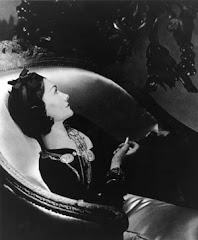Last week I wrote about Net a Porter's decision to sell two dresses from the previous day's Halston show on its site.
Cathy Horyn, the New York Times' fashion writer decided to order a dress having actually seen the show. And here's what happened:
The dress arrived Wednesday afternoon at the office. The delay didn’t really bother me. What’s one day compared to waiting five or six months, as you normally would for a fall 2008 dress. But I was disappointed with the dress. Although Net-a-Porter had clearly described the dress as wool jersey, I had seen the style in the show—and it was in sleek silk satin and a warmer tone. Further, the dress didn’t seem to be worth $1,495. Unlike the thousands of women who logged into Net-a-Porter, I had had the advantage of seeing the collection in the studio and on the runway, and the clothes had seemed more substantial to me. I was also having trouble seeing what distinguished this wool jersey dress from another designer make, and, frankly, I had been seduced by the silk version on the runway. It looked cooler. Also, the dress didn’t fit—that was my fault. I should have gone for the 42—or, anyway, something smaller. I looked a little schlumpfy, if you know what I mean.
The Halston’s wool jersey dress that Ms. Horyn ordered, size 44, from Net-a-porter. (Evan Sung for The New York Times)
Was this a case of bait and switch? Was the wool jersey shirt dress part of the runway collection or was it a so-called commercial look done specially for Net-a-Porter’s Halston sale?
A day or so later, I learned that the wool jersey dress was supposed to be on the runway—it’s listed, in fact, on the run-of-show—but at the last minute Marco Zanini, the Halston designer, had pulled it and substituted the satin shirt-dress. Zanini told me yesterday that he had switched dresses because there was already a lot of wool jersey on the runway—one of the long, draw-string evening dresses is in the same fabric, as is a teal gown.
what was on the runway
I also telephoned Bonnie Takhar, the chief executive of Halston, and shared my consumerist misgivings about the dress. She was concerned. She said the dress came from the same factory that had made the samples, so the quality should be identical. (Neither Takhar nor Massenet will say how large the initial Net-a-Porter was, but production and delivery of the garments from the factory took about 30 days, which Takhar said was normal.)
Anyway, I said to Takhar that, apart from the size, maybe the problem was the dress didn’t seem in the same stylish company as the other runway pieces, and not as flattering (to my eye) as the satin shirt dress. Obviously it would have helped if BOTH styles, the low-back draped shift and the jersey shirt dress, had been on the runway, given all the ballyhoo about the runway-to-consumer concept. Takhar agreed. She then offered to have my dress styled as it would have appeared on the runway.
Which Zanini did yesterday, using a size-44 model and pairing the dress with a sleeveless cashmere turtleneck and high suede boots. In Halston’s defense, it looked great—and better, I think, without the sash belt that comes with each dress. Net-a-Porter has sold out of the brown shirt dress, though it still has a size left in the teal, and Massenet told me last Friday that she had not heard any displeasure from customers.









